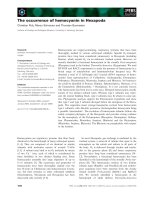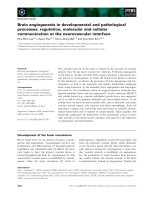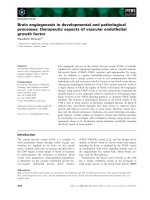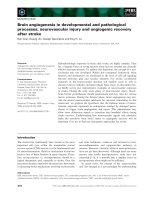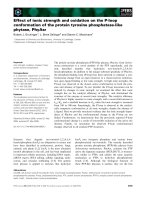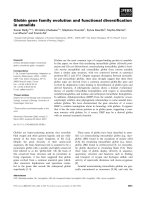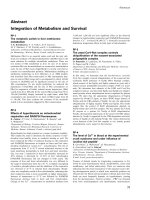Tài liệu Báo cáo khoa học: "GF Parallel Resource Grammars and Russian" docx
Bạn đang xem bản rút gọn của tài liệu. Xem và tải ngay bản đầy đủ của tài liệu tại đây (112.93 KB, 8 trang )
Proceedings of the COLING/ACL 2006 Main Conference Poster Sessions, pages 475–482,
Sydney, July 2006.
c
2006 Association for Computational Linguistics
GF Parallel Resource Grammars and Russian
Janna Khegai
Department of Computer Science
Chalmers University of Technology
SE-41296 Gothenburg, Sweden
Abstract
A resource grammar is a standard library
for the GF grammar formalism. It raises
the abstraction level of writing domain-
specific grammars by taking care of the
general grammatical rules of a language.
GF resource grammars have been built in
parallel for eleven languages and share a
common interface, which simplifies multi-
lingual applications. We reflect on our ex-
perience with the Russian resource gram-
mar trying to answer the questions: how
well Russian fits into the common inter-
face and where the line between language-
independent and language-specific should
be drawn.
1 Introduction
Grammatical Framework (GF) (Ranta, 2004) is a
grammar formalism designed in particular to serve
as an interlingua platform for natural language ap-
plications in sublanguage domains. A domain can
be described using the GF grammar formalism and
then processed by GF. Such descriptions are called
application grammars.
A resource grammar (Ranta, to appear) is a
general-purpose grammar that forms a basis for
application grammars. Resource grammars have
so far been implemented for eleven languages in
parallel. The structural division into abstract and
concrete descriptions, advocated in GF, is used
to separate the language-independent common in-
terface or Application Programming Interface
(API) from corresponding language-specific im-
plementations. Consulting the abstract part is suf-
ficient for writing an application grammar without
descending to implementation details. This ap-
proach raises the level of application grammar de-
velopment and supports multilinguality, thus, pro-
viding both linguistic and computational advan-
tages.
The current coverage is comparable with the
Core Language Engine (CLE) project (Rayner
et al., 2000). Other well-known multilingual
general-purpose grammar projects that GF can
be related to, are LFG grammars (Butt et al.,
1999) and HPSG grammars (Pollard and Sag,
1994), although their parsing-oriented unification-
based formalisms are very different from the
GF generation-oriented type-theoretical formal-
ism (Ranta, 2004).
A Russian resource grammar was added after
similar grammars for English, Swedish, French
and German (Arabic, Italian, Finnish, Norwegian,
Danish and Spanish are also supported in GF). A
language-independent API representing the cover-
age of the resource library, therefore, was already
available. The task was to localize modules for
Russian.
A resource grammar has morphological and
syntactic modules. Morphological modules in-
clude a description of word classes, inflectional
paradigms and a lexicon. Syntactic modules com-
prise a description of phrasal structures for ana-
lyzing bigger than one-word entities and various
combination rules. Note, that semantics, defining
the meanings of words and syntactic structures,
is constructed in application grammars. This is
because semantics is rather domain-specific, and,
thus, it is much easier to construct a language-
independent semantic model for a particular do-
main than a general-purpose resource semantics.
In the following sections we consider typical
definitions from different resource modules focus-
ing on aspects specific to Russian. We will also
475
demonstrate the library usage in a sample applica-
tion grammar.
2 Word Classes
Every resource grammar starts with a descrip-
tion of word classes. Their names belong to
the language-independent API, although their im-
plementations are language-specific. Russian fits
quite well into the common API here, since like
all other languages it has nouns, verbs, adjectives
etc. The type system for word classes of a lan-
guage is the most stable part of the resource gram-
mar library, since it follows traditional linguis-
tic descriptions (Shelyakin, 2000; Wade, 2000;
Starostin, 2005). For example, let us look at
the implementation of the Russian adjective type
AdjDegree:
param
Degree = Pos | Comp | Super;
Case = Nom|Gen|Dat|Acc|Inst|Prep;
Animacy = Animate | Inanimate;
Gender = Masc | Fem | Neut;
GenNum = ASingular Gender|APlural;
AdjForm = AF Case Animacy GenNum;
oper
AdjDegree : Type =
{s : Degree => AdjForm => Str};
First, we need to specify parameters (param) on
which inflection forms depend. A vertical slash
(|) separates different parameter values. While in
English the only parameter would be comparison
degree (Degree), in Russian we have many more
parameters:
• Case, for example: bolьxie doma –
bolьxih domov (big houses – big houses’).
• Animacy only plays a role in the ac-
cusative case (Acc) in masculine (Masc)
singular (ASingular) and in plural forms
(APlural), namely, accusative animate
form is the same as genitive (Gen) form,
while accusative inanimate form is the same
as nominative (Nom): lbl bolьxie
doma – lbl bolьxih muжqin (I love
big houses – I love big men).
• Gender only plays role in singular:
bolьxo dom – bolьxa maxina (big
house – big car). The plural never makes
a gender distinction, thus, Gender and
number are combined in the GenNum pa-
rameter to reduce redundant inflection table
items. The possible values of GenNum are
ASingular Masc, ASingular Fem,
ASingular Neut and APlural.
• Number, for instance: bolьxo dom –
bolьxie doma (a big house – big houses).
• Degree can be more complex, since most
Russian adjectives have two comparative
(Comp) forms: declinable attributive and
indeclinable predicative
1
: bolee vysoki
(more high) – vyxe (higher), and more
than one superlative (Super) forms: samy
vysoki (the most high) – naivysxi (the
highest).
Even another parameter can be added, since
Russian adjectives in the positive (Pos) degree
have long and short forms: spokona reka (the
calm river) – reka – spokona (the river is
calm). The short form has no case declension,
thus, it can be considered as an additional case
(Starostin, 2005). Note, that although the predica-
tive usage of the long form is perfectly grammat-
ical, it can have a slightly different meaning com-
pared to the short form. For example: long, pred-
icative on – bolьno (”he is crazy”) vs. short,
predicative on – bolen (”he is ill”).
An oper judgement combines the name of
the defined operation, its type, and an expres-
sion defining it. The type for degree adjec-
tive (AdjDegree) is a table of strings (s:
=> => Str) that has two main dimensions:
Degree and AdjForm, where the last one is a
combination of the parameters listed above. The
reason to have the Degree parameter as a sepa-
rate dimension is that a special type of adjectives
Adj that just have positive forms is useful. It in-
cludes both non-degree adjective classes: posses-
sive, like mamin (mother’s), lisi (fox’es), and
relative, like russki (Russian).
As a part of the language-independent API, the
name AdjDegree denotes the adjective degree
type for all languages, although each language has
its own implementation. Maintaining parallelism
among languages is rather straightforward at this
stage, since the only thing shared is the name of
1
The English -er/more and -est/most variations are exclu-
sive, while in Russian both forms are valid.
476
a part of speech. A possible complication is that
parsing with inflectionally rich languages can be
less efficient compared to, for instance, English.
This is because in GF all forms of a word are kept
in the same declension table, which is convenient
for generation, since GF is a generation-oriented
grammar formalism. Therefore, the more forms
there are, the bigger tables we have to store in
memory, which can become an issue as the gram-
mars grow and more languages are added (Dada
and Ranta, 2006).
3 Inflection Paradigms and Lexicon
Besides word class declarations, morphology
modules also contain functions defining common
inflectional patterns (paradigms) and a lexicon.
This information is language-specific, so fitting
into the common API is not a consideration here.
Paradigms are used to build the lexicon incremen-
tally as new words are used in applications. A lex-
icon can also be extracted from other sources.
Unlike syntactic descriptions, morphological
descriptions for many languages have been al-
ready developed in other projects. Thus, consid-
erable efforts can be saved by reusing existing
code. How easy we can perform the transforma-
tion depends on how similar the input and output
formats are. For example, the Swedish morphol-
ogy module is generated automatically from the
code of another project, called Functional Mor-
phology (Forsberg and Ranta, 2004). In this case
the formats are very similar, so extracting is rather
straightforward. However, this might not be the
case if we build the lexicon from a very different
representation or even from corpora, where post-
modification by hand is simply inevitable.
A paradigm function usually takes one or more
string arguments and forms a lexical entry. For
example, the function nGolova describes the in-
flectional pattern for feminine inanimate nouns
ending with -a in Russian. It takes the basic form
of a word as a string (Str) and returns a noun (CN
stands for Common Noun, see definition in sec-
tion 4). Six cases times two numbers gives twelve
forms, plus two inherent parameters Animacy
and Gender (defined in section 2):
oper
nGolova: Str -> CN = \golova ->
let golov = init golova in {
s = table {
SF Sg Nom => golov+"a";
SF Sg Gen => golov+"y";
SF Sg Dat => golov+"e";
SF Sg Acc => golov+"u";
SF Sg Inst => golov+"o";
SF Sg Prepos => golov+"e";
SF Pl Nom => golov+"y";
SF Pl Gen => golov;
SF Pl Dat => golov+"am";
SF Pl Acc => golov+"y";
SF Pl Inst => golov+"ami ";
SF Pl Prepos => golov+"ah" };
g = Fem;
anim = Inanimate };
where \golova is a λ-abstraction, which means
that the function argument of the type Str will be
denoted as golova in the definition. The con-
struction let in is used to extract the word
stem (golov), in this case, by cutting off the last
letter (init). Of course, one could supply the
stem directly, however, it is easier for the gram-
marian to just write the whole word without wor-
rying what stem it has and let the function take
care of the stem automatically. The table structure
is simple – each line corresponds to one parame-
ter value. The sign => separates parameter values
from corresponding inflection forms. Plus sign de-
notes string concatenation.
The type signature (nGolova: Str ->
CN) and maybe a comment telling that the
paradigm describes feminine inanimate nouns
ending with -a are the only things the grammar-
ian needs to know, in order to use the func-
tion nGolova. Implementation details (the in-
flection table) are hidden. The name nGolova
is actually a transliteration of the Russian word
golova (head) that represents nouns conforming
to the pattern. Therefore, the grammarian can just
compare a new word to the word golova in or-
der to decide whether nGolova is appropriate.
For example, we can define the word mashina
(maxina) corresponding to the English word car.
Maxina is a feminine, inanimate noun ending
with -a. Therefore, a new lexical entry for the
word maxina can be defined by:
oper mashina = nGolova "maxina" ;
Access via type signature becomes especially
helpful with more complex parts of speech like
verbs.
Lexicon and inflectional paradigms are
language-specific, although, an attempt to build
477
a general-purpose interlingua lexicon in GF has
been made. Multilingual dictionary can work
for words denoting unique objects like the sun
etc., but otherwise, having a common lexicon
interface does not sound like a very good idea or
at least something one would like to start with.
Normally, multilingual dictionaries have bilingual
organization (Kellogg, 2005).
At the moment the resource grammar has an
interlingua dictionary for, so called, closed word
classes like pronouns, prepositions, conjunctions
and numerals. But even there, a number of dis-
crepancies occurs. For example, the impersonal
pronoun one (OnePron) has no direct corre-
spondence in Russian. Instead, to express the
same meaning Russian uses the infinitive: esli
oqenь zahotetь, moжno v kosmos uletetь
(if one really wants, one can fly into the space).
Note, that the modal verb can is transformed
into the adverb moжno (it is possible). The
closest pronoun to one is the personal pronoun
ty (you), which is omitted in the final sen-
tence: esli oqenь zahoqexь, moжexь v kos-
mos uletetь. The Russian implementation of
OnePron uses the later construction, skipping the
string (s), but preserving number (n), person (p)
and animacy (anim) parameters, which are nec-
essary for agreement:
oper OnePron: Pronoun = {
s = "";
n = Singular;
p = P2;
anim = Animate };
4 Syntax
Syntax modules describe rules for combining
words into phrases and sentences. Designing a
language-independent syntax API is the most dif-
ficult part: several revisions have been made as the
resource coverage has grown. Russian is very dif-
ferent from other resource languages, therefore, it
sometimes fits poorly into the common API.
Several factors have influenced the API struc-
ture so far: application domains, parsing algo-
rithms and supported languages. In general, the
resource syntax is built bottom-up, starting with
rules for forming noun phrases and verb phrases,
continuing with relative clauses, questions, imper-
atives, and coordination. Some textual and dia-
logue features might be added, such as contrast-
ing, topicalization, and question-answer relations.
On the way from dictionary entries towards
complete sentences, categories loose declension
forms and, consequently, get more parameters that
”memorize” what forms are kept, which is neces-
sary to arrange agreement later on. Closer to the
end of the journey string fields are getting longer
as types contain more complex phrases, while pa-
rameters are used for agreement and then left be-
hind. Sentence types are the ultimate types that
just contain one string and no parameters, since
everything is decided and agreed on by that point.
Let us take a look at Russian nouns as an exam-
ple. A noun lexicon entry type (CN) mentioned in
section 3 is defined like the following:
param
SubstForm = SF Number Case;
oper
CN: Type = {
s: SubstForm => Str;
g: Gender;
anim: Animacy };
As we have seen in section 3, the string table field
s contains twelve forms. On the other hand, to
use a noun in a sentence we need only one form
and several parameters for agreement. Thus, the
ultimate noun type to be used in a sentence as an
object or a subject looks more like Noun Phrase
(NP):
oper NP : Type = {
s: Case => Str;
Agreement: {
n: Number;
p: Person;
g: Gender;
anim: Animacy} };
which besides Gender and Animacy also con-
tains Number and Person parameters (defined
in section 2), while the table field s only contains
six forms: one for each Case value.
The transition from CN to NP can be done via
various intermediate types. A noun can get modi-
fiers like adjectives – krasna komnata (the red
room), determiners – mnogo xuma (much ado),
genitive constructions – gero naxego vremeni
(a hero of our time), relative phrases – qelovek,
kotory smets (the man who laughs). Thus,
the string field (s) can eventually contain more
than one word. A noun can become a part of other
phrases, e.g. a predicate in a verb phrase – znanie
– sila (knowledge is power) or a complement
478
in a prepositional phrase – za reko, v teni
derevьev (across the river and into the trees).
The language-independent API has an hierarchy
of intermediate types all the way from dictionary
entries to sentences. All supported languages fol-
low this structure, although in some cases this does
not happen naturally. For example, the division
between definite and indefinite noun phrases is not
relevant for Russian, since Russian does not have
any articles, while being an important issue about
nouns in many European languages. The common
API contains functions supporting such division,
which are all conflated into one in the Russian im-
plementation. This is a simple case, where Rus-
sian easily fits into the common API, although a
corresponding phenomenon does not really exist.
Sometimes, a problem does not arise until the
joining point, where agreement has to be made.
For instance, in Russian, numeral modification
uses different cases to form a noun phrase in nom-
inative case: tri tovariwa (three comrades),
where the noun is in nominative, but ptь to-
variwe (five comrades), where the noun is in
genitive! Two solutions are possible. An extra
non-linguistic parameter bearing the semantics of
a numeral can be included in the Numeral type.
Alternatively, an extra argument (NumberVal),
denoting the actual number value, can be in-
troduced into the numeral modification function
(IndefNumNP) to tell apart numbers with the last
digit between 2 and 4 from other natural numbers:
oper IndefNumNP: NumberVal ->
Numeral -> CN -> NP;
Unfortunately, this would require changing
the language-independent API (adding the
NumberVal argument) and consequent adjust-
ments in all other languages that do not need
this information. Note, that IndefNumNP,
Numeral, CN (Common Noun) and NP (Noun
Phrase) belong to the language-independent
API, i.e. they have different implementations in
different languages. We prefer the encapsulation
version, since the other option will make the
function more error-prone.
Nevertheless, one can argue for both solutions,
which is rather typical while designing a com-
mon interface. One has to decide what should
be kept language-specific and what belongs to the
language-independent API. Often this decision is
more or less a matter of taste. Since Russian is
not the main language in the GF resource library,
the tendency is to keep things language-specific at
least until the common API becomes too restric-
tive for a representative number of languages.
The example above demonstrates a syntactic
construction, which exist both in the language-
independent API and in Russian although the com-
mon version is not as universal as expected. There
are also cases, where Russian structures are not
present in the common interface at all, since there
is no direct analogy in other supported languages.
For instance, a short adjective form is used in
phrases like mne nuжna pomowь (I need help)
and e interesno iskusstvo (she is interested
in art). In Russian, the expressions do not have
any verb, so they sound like to me needed help
and to her interesting art, respectively. Here is the
function predShortAdj describing such adjec-
tive predication
2
specific to Russian:
oper predShortAdj: NP -> Adj ->
NP -> S = \I, Needed, Help -> {
s = let {
toMe = I.s ! Dat;
needed = Needed.s !
AF Short Help.g Help.n;
help = Help.s ! Nom
} in
toMe ++ needed ++ help };
predShortAdj takes three arguments: a non-
degree adjective (Adj) and two noun phrases (NP)
that work as a predicate, a subject and an object in
the returned sentence (S). The third line indicates
that the arguments will be denoted as Needed, I
and Help, respectively (λ-abstraction). The sen-
tence type (S) only contains one string field s. The
construction let in is used to first form the
individual words (toMe, needed and help) to
put them later into a sentence. Each word is pro-
duced by taking appropriate forms from inflection
tables of corresponding arguments (Needed.s,
Help.s and I.s). In the noun arguments I
and Help dative and nominative cases, respec-
tively, are taken (!-sign denotes the selection op-
eration). The adjective Needed agrees with the
noun Help, so Help’s gender (g) and number
(n) are used to build an appropriate adjective form
(AF Short Help.g Help.n). This is ex-
actly where we finally use the parameters from
Help argument of the type NP defined above.
We only use the declension tables from the argu-
2
In this example we disregard adjective past/future tense
markers bylo/budet.
479
ments I and Needed – other parameters are just
thrown away. Note, that predShortAdj uses
the type Adj for non-degree adjectives instead of
AdjDegree presented in section 2. We also use
the Short adjective form as an extra Case-value.
5 An Example Application Grammar
The purpose of the example is to show similarities
between the same grammar written for different
languages using the resource library. Such similar-
ities increase the reuse of previously written code
across languages: once written for one language
a grammar can be ported to another language
relatively easy and fast. The more language-
independent API functions (names conventionally
starting with a capital letter) a grammar contains,
the more efficient the porting becomes.
We will consider a fragment of Health – a
small phrase-book grammar written using the re-
source grammar library in English, French, Ital-
ian, Swedish and Russian. It can form phrases like
she has a cold and she needs a painkiller. The fol-
lowing categories (cat) and functions (fun) con-
stitute language-independent abstract syntax (do-
main semantics):
cat
Patient; Condition;
Medicine; Prop;
fun
ShePatient: Patient;
CatchCold: Condition;
PainKiller: Medicine;
BeInCondition: Patient ->
Condition -> Prop;
NeedMedicine: Patient ->
Medicine -> Prop;
And: Prop -> Prop -> Prop;
Abstract syntax determines the class of statements
we are able to build with the grammar. The cat-
egory Prop denotes complete propositions like
she has a cold. We also have separate categories
of smaller units like Patient, Medicine and
Condition. To produce a proposition one can,
for instance, use the function BeInCondition,
which takes two arguments of the types Patient
and Condition and returns the result of the type
Prop. For example, we can form the phrase she
has a cold by combining three functions above:
BeInCondition
ShePatient CatchCold
where ShePatient and CatchCold are
constants used as arguments to the function
BeInCondition.
Concrete syntax translates abstract syntax into
natural language strings. Thus, concrete syntax is
language-specific. However, having the language-
independent resource API helps to make even a
part of concrete syntax shared among the lan-
guages:
lincat
Patient = NP;
Condition = VP;
Medicine = CN;
Prop = S;
lin
And = ConjS;
ShePatient = SheNP;
BeInCondition = PredVP;
The first group (lincat) tells that the semantic
categories Patient, Condition, Medicine
and Prop are expressed by the resource linguis-
tic categories: noun phrase (NP), verb phrase
(VP), common noun (CN) and sentence (S), re-
spectively. The second group (lin) tells that the
function And is the same as the resource coordina-
tion function ConjS, the function ShePatient
is expressed by the resource pronoun SheNP
and the function BeInCondition is expressed
by the resource function PredVP (the classic
NP
VP->S rule). Exactly the same rules work for
all five languages, which makes the porting triv-
ial
3
. However, this is not always the case.
Writing even a small grammar in an inflection-
ally rich language like Russian requires a lot of
work on morphology. This is the part where us-
ing the resource grammar library may help, since
resource functions for adding new lexical entries
are relatively easy to use. For instance, the word
painkiller is defined similarly in five languages by
taking a corresponding basic word form as an ar-
gument to an inflection paradigm function:
English:
PainKiller = regN "painkiller";
French:
PainKiller = regN "calmant";
Italian:
PainKiller = regN "calmante";
3
Different languages can actually share the same code us-
ing GF parameterized modules (Ranta, to appear)
480
Swedish:
PainKiller = regGenN
"sm
¨
artstillande" Neut;
Russian:
PainKiller = nEe "obezbolivawee";
The Gender parameter (Neut) is provided for
Swedish.
In the remaining functions we see bigger dif-
ferences: the idiomatic expressions I have a cold
in French, Swedish and Russian is formed by ad-
jective predication, while a transitive verb con-
struction is used in English and Italian. There-
fore, different functions (PosA and PosTV) are
applied. tvHave and tvAvere denote transitive
verb to have in English and Italian, respectively.
IndefOneNP is used for forming an indefinite
noun phrase from a noun in English and Italian:
English:
CatchCold = PosTV tvHave
(IndefOneNP (regN "cold"));
Italian:
CatchCold = PosTV tvAvere
(IndefOneNP (regN "raffreddore"));
French:
CatchCold = PosA (regA "enrhum
´
e")
Swedish:
CatchCold = PosA
(mk2A "f
¨
orkyld" "f
¨
orkylt");
Russian:
CatchCold = PosA
(adj
yj "prostuжen");
In the next example the Russian version is rather
different from the other languages. The phrase
I need a painkiller is a transitive verb predica-
tion together with complementation rule in En-
glish and Swedish. In French and Italian we need
to use the idiomatic expressions avoir besoin and
aver bisogno. Therefore, a classic NP
VP rule
(PredVP) is used. In Russian the same meaning
is expressed by using adjective predication defined
in section 4:
English:
NeedMedicine pat med = predV2
(dirV2 (regV "need"))
pat (IndefOneNP med);
Swedish:
NeedMedicine pat med = predV2
(dirV2 (regV "beh
¨
over"))
pat (DetNP nullDet med);
French:
NeedMedicine pat med = PredVP
pat (avoirBesoin med);
Italian:
NeedMedicine pat med = PredVP
pat (averBisogno med);
Russian:
NeedMedicine pat med =
predShortAdj pat
(adj
yj "nuжen") med;
Note, that the medicine argument (med) is used
with indefinite article in the English version
(IndefOneNP), but without articles in Swedish,
French and Italian. As we have mentioned
in section 4, Russian does not have any arti-
cles, although the corresponding operations ex-
ist for the sake of consistency with the language-
independent API.
Health grammar shows that the more similar
languages are, the easier porting will be. How-
ever, as with traditional translation the grammar-
ian needs to know the target language, since it is
not clear whether a particular construction is cor-
rect in both languages, especially, when the lan-
guages seem to be very similar in general.
6 Conclusion
GF resource grammars are general-purpose gram-
mars used as a basis for building domain-specific
application grammars. Among pluses of using
such grammar library are guaranteed grammatical-
ity, code reuse (both within and across languages)
and higher abstraction level for writing application
grammars. According to the ”division of labor”
principle, resource grammars comprise the nec-
essary linguistic knowledge allowing application
grammarians to concentrate on domain semantics.
Following Chomsky’s universal grammar hy-
pothesis (Chomsky, 1981), GF multilingual re-
source grammars maintain a common API for all
supported languages. This is implemented using
481
GF’s mechanism of separating between abstract
and concrete syntax. Abstract syntax declares uni-
versal principles, while language-specific parame-
ters are set in concrete syntax. We are not trying to
answer the general question what constitutes uni-
versal grammar and what beyond universal gram-
mar differentiates languages from one another. We
look at GF parallel resource grammars as a way to
simplify multilingual applications.
The implementation of the Russian resource
grammar proves that GF grammar formalism al-
lows us to use the language-independent API for
describing sometimes rather peculiar grammatical
variations in different languages. However, main-
taining parallelism across languages has its lim-
its. From the beginning we were trying to put as
much as possible into a common interface, shared
among all the supported languages. Word classes
seem to be rather universal at least for the eleven
supported languages. Syntactic types and some
combination rules are more problematic. For ex-
ample, some Russian rules only make sense as
a part of language-specific modules while some
rules that were considered universal at first are not
directly applicable to Russian.
Having a universal resource API and grammars
for other languages has made developing Rus-
sian grammar much easier comparing to doing it
from scratch. The abstract syntax part was simply
reused. Some concrete syntax implementations
like adverb description, coordination and subor-
dination required only minor changes. Even for
more language-specific rules it helps a lot to have
a template implementation that demonstrates what
kind of phenomena should be taken into account.
The GF resource grammar development is
mostly driven by application domains like soft-
ware specifications (Burke and Johannisson,
2005), math problems (Caprotti, 2006) or trans-
port network dialog systems (Bringert et al.,
2005). The structure of the resource grammar li-
brary is continually influenced by new domains
and languages. The possible direction of GF par-
allel resource grammars’ development is extend-
ing the universal interface by domain-specific and
language-specific parts. Such adaptation seems to
be necessary as the coverage of GF resource gram-
mars grows.
Acknowledgements
Thanks to Professor Arto Mustajoki for fruitful
discussions and to Professor Robin Cooper for
reading and editing the final version of the paper.
Special thanks to Professor Aarne Ranta, my su-
pervisor and the creator of GF.
References
B. Bringert, R. Cooper, P. Ljungl
¨
of, and A. Ranta.
2005. Multimodal Dialogue System Grammars. In
DIALOR’05, Nancy, France.
D.A. Burke and K. Johannisson. 2005. Translating
Formal Software Specifications to Natural Language
/ A Grammar-Based Approach. In LACL 2005,
LNAI 3402, pages 51–66. Springer.
M. Butt, T. H. King, M E. Ni no, and F. Segond, edi-
tors. 1999. A Grammar Writer’s Cookbook. Stan-
ford: CSLI Publications.
O. Caprotti. 2006. WebALT! Deliver Mathematics Ev-
erywhere. In SITE 2006, Orlando, USA.
N. Chomsky. 1981. Lectures on Government and
Binding: The Pisa Lectures. Dordrecht, Holland:
Foris Publications.
A. E. Dada and A. Ranta. 2006. Implement-
ing an arabic resource grammar in grammatical
framework. At 20th Arabic Linguistics Sym-
posium, Kalamazoo, Michigan. URL: www.md
stud.chalmers.se/˜eldada/paper.pdf.
M. Forsberg and A. Ranta. 2004. Functional morphol-
ogy. In ICFP’04, pages 213–223. ACM Press.
M. Kellogg. 2005. Online french, italian and spanish
dictionary. URL: www.wordreference.com.
C. Pollard and I. Sag. 1994. Head-Driven Phrase
Structure Grammar. University of Chicago Press.
A. Ranta. 2004. Grammatical Framework: A Type-
theoretical Grammar Formalism. The Journal of
Functional Programming, 14(2):145–189.
A. Ranta. to appear. Modular Grammar Engineer-
ing in GF. Research in Language and Computa-
tion. URL: www.cs.chalmers.se/˜aarne/
articles/ar-multieng.pdf
M. Rayner, D. Carter, P. Bouillon, V. Digalakis, and
M. Wir
´
en. 2000. The spoken language translator.
Cambridge University Press.
M.A. Shelyakin. 2000. Spravochnik po russkoj gram-
matike (in Russian). Russky Yazyk, Moscow.
S. Starostin. 2005. Russian morpho-engine on-line.
URL: starling.rinet.ru/morph.htm.
T. Wade. 2000. A Comprehensive Russian Grammar.
Blackwell Publishing.
482


